If you’re an art lover, you don’t want to miss the Piero della Francesca Trail in central Italy. This guide will take you to all the best places to see the magnificent artwork of this legendary Italian Renaissance artist.
For years, people from all walks of life have made the pilgrimage to central Italy to see Piero’s stunning works of art in person. With a mix of in situ pieces and otherworldly creations, this trail is a feast for the eyes.
Piero is widely regarded as a genius and a foundational artist of the early Renaissance period, known as the Quattrocento. During his lifetime, he was held in the highest esteem, like a monarch among artists.
But, in the 17th century, his sublime works sunk into obscurity. Piero was only rediscovered with fervor in the mid-19th century, when Americans and Europeans began taking their Grand Tours in Europe.
His renown spread further when famous art historian John Pope-Hennessy gave a lecture on Piero at the Metropolitan Museum of Art in 1991.
Further time has only enhanced Piero’s reputation, approaching a cult-like icono-mania. Today, Piero is widely acknowledged as one of the giants of the era, rivaling even Leonardo da Vinci.
Still, Piero is “almost famous.” You may not have heard of Piero, unless you’re a Renaissance devotee.
His work doesn’t get as much attention from Italy travelers as other giants like Michelangelo or Leonardo. With only a few exceptions, Piero’s artwork isn’t in the convenient museums in Italy’s major touristic cities of Rome, Milan, Venice, and Florence.
Rather, Piero’s works are found exactly where they were painted. If you want to see them, you’ve got to get off the beaten path and head to some tiny towns in southern Tuscany and Le Marche. The locals have actually created and advertise a Piero della Francesca Trail, which we’ll follow.
A Short Biography of Piero Della Francesca
In or around 1415, Piero burst forth into the world in the Tuscan backwater of Sansepolcro. He was born into a prosperous family of leather makers and indigo merchants.
As a merchant’s son, he was trained as a mathematician. Later in life, Piero gained fame in that field, schooling Italians on Euclid and Greek scientists.
But Piero’s first vocation was painting. Historians don’t know much about his life and formation as an artist. His first documented exposure was in Florence.
And what better training than in the “Cradle of the Renaissance?” Piero likely met and had direct access to the works and influence of the greatest artists in Italy at the time — Fra Angelico, Donatello, Masaccio, Ghiberti, etc. There was no better time to be training as an artist in Florence than in the early 15th century.
READ: Guide To Fra Angelico’s San Marco Monastery in Florence
In 1439, it’s recorded that Piero collaborated with Florentine artist Domenico Veneziano. Piero took from Domenico a love of luminous pastel palettes.
His compositions were also influenced by the Florentine artist Masaccio and the Flemish artist Rogier van der Weyden. The Flemish artists prompted Piero to bring oil painting to Italy, which became a staple medium of the high Renaissance. By 1450, Piero was executing commissions in Venice.
READ: Must See Sties in Venice
Piero was a notable math scholar, publishing three treatises on mathematics and perspective. In his day, he was known as much for math as art. Perhaps too analytic, Piero wasn’t a terribly prolific artist. He worked slowly, and some of his work was lost or destroyed.
READ: Isabella Stewart Gardner Museum in Boston (with a rare Piero painting in the US)
Piero’s mathematical prowess informed his art. He experimented with the architect Leon Battista Alberti’s theories on perspective and vanishing points.
Piero’s works are highly linear and calculated, characterized by an infused calm and geometric sobriety. His cool tones and unmoving figures created a dream-like sense of timeless stillness.
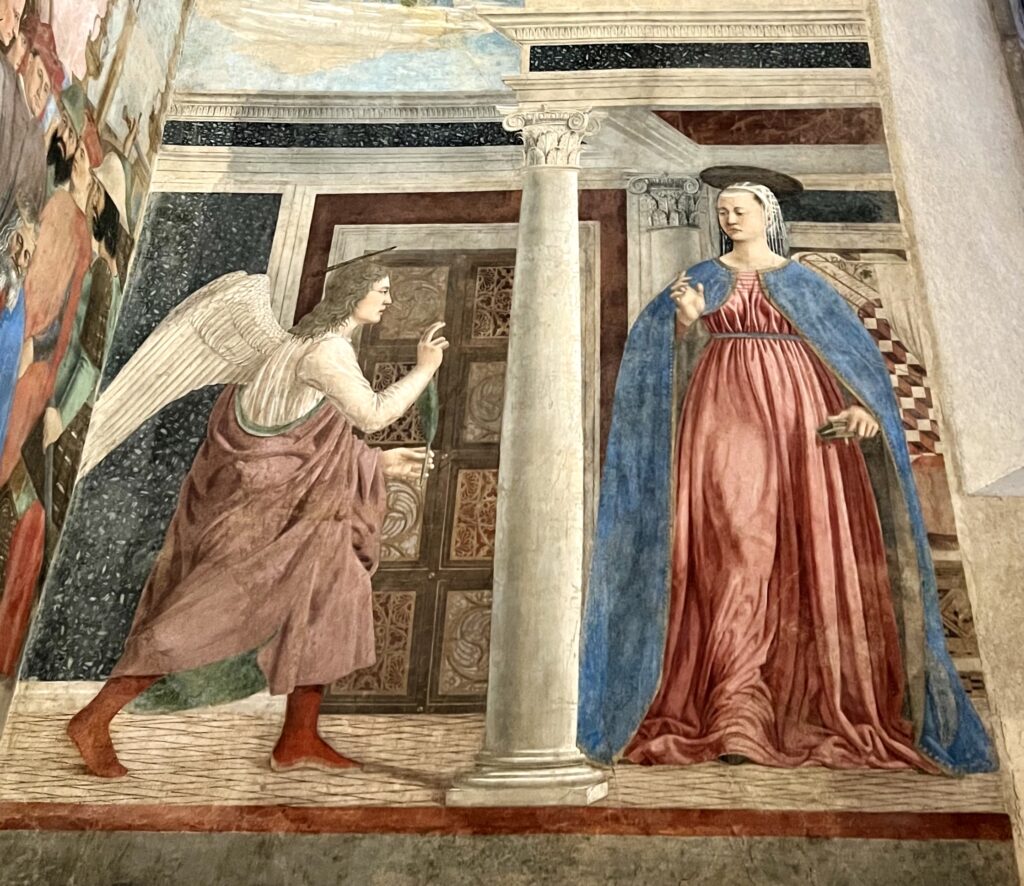
Piero’s formalism is clean and clear, which almost makes a fresco cycle like Michelangelo’s Sistine Chapel seem too busy and extravagant by comparison.
Piero’s figures were also highly realistic. Like Giotto, he was one of the first artists to capture realistic faces that show emotion and have a spark of individuality. Piero’s figures were likely shocking to 15th century viewers used to the stylized and gilded figures of the Gothic era.
Today, there is an official “Piero Trail” in southern Tuscany, taking you to Arezzo, Sansepolcro, Monterchi, Urbino, and Rimini. Piero’s works there don’t “move.” Most of them are in situ or detached frescos in towns that won’t lend his rare pieces. So, you have to travel or road trip to where Piero painted them in Italy.
READ: 10 Day Itinerary For Tuscany
The Piero della Francesca Trail In Italy
If you’re a fan of Piero della Francesca, this Italy guide is for you! It lets you walk in the footsteps of the great Renaissance artist on the official Piero della Francesca Trail in southern Tuscany and Le Marche.
The area around Arezzo is particularly rich in Piero’s artwork and is known as “The Land of Piero.” This itinerary starts in Arezzo and takes you on a journey through Umbria and Le Marche before finishing on the East coast in Rimini.
In addition to the official trail, this guide also takes you to some of Italy’s most famous cities, including Venice, Milan, and Florence. Each city has one famous Piero painting that is a must see for any art lover on a Piero pilgrimage.
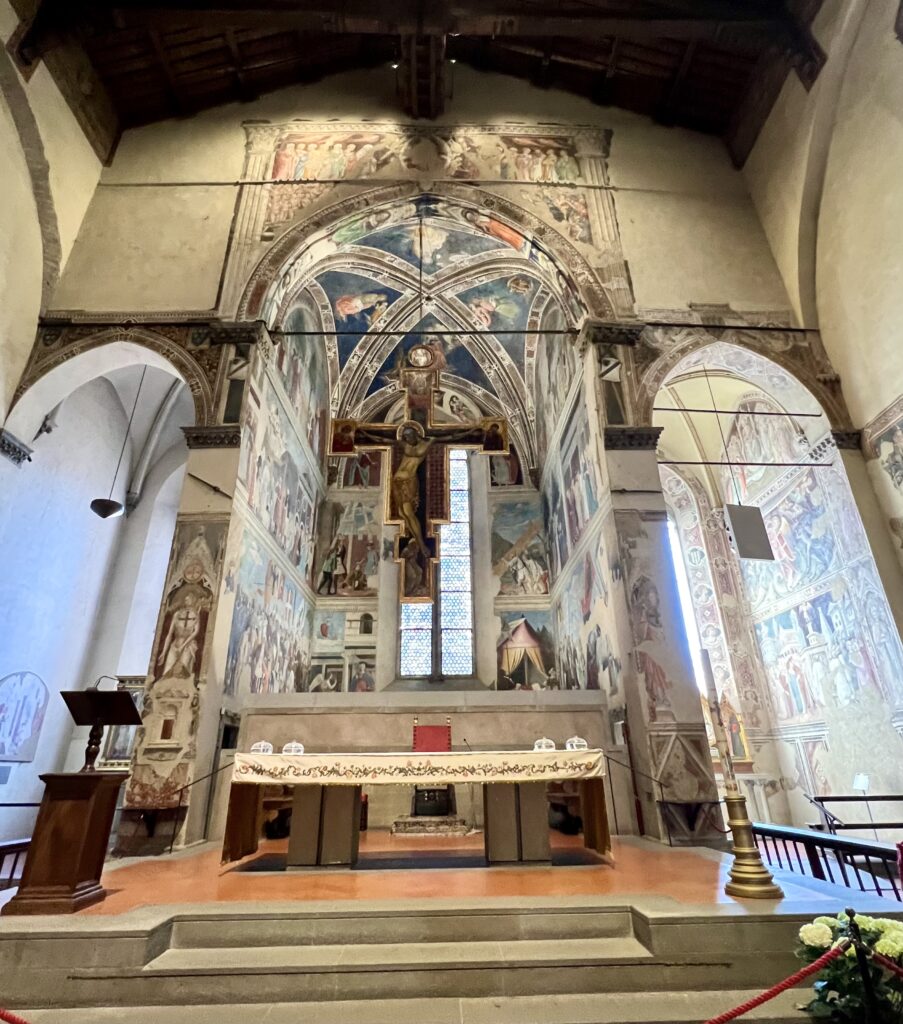
1. Arezzo, Basilica of San Francesco
Piero della Francesca’s masterpiece — a Piero without peer — is his most magnificent fresco cycle, The Legend of the True Cross. The cycle is located in the lovely little Tuscan town of Arezzo, in the three story main chapel of the Basilica of San Francesco. Arezzo is only 30 miles south of Florence, so the town is one of the best day trips from Florence.
Piero’s work is one of the greatest and most beautiful fresco cycles from the early Renaissance. Some art historians believe Piero’s work in the Bacci Chapel is second only to the Sistine Chapel in the Vatican Museums, though I am also partial to Giotto’s Scrovegni Chapel in Padua.
British writer Aldous Huxley called The Legend of the True Cross “the most beautiful painting in the world.”
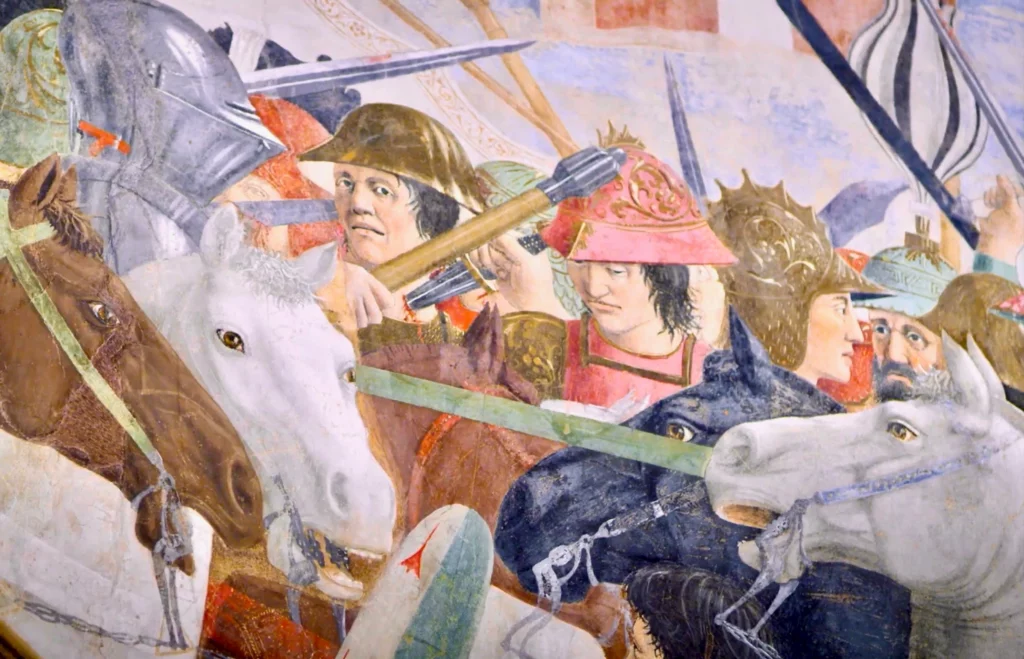
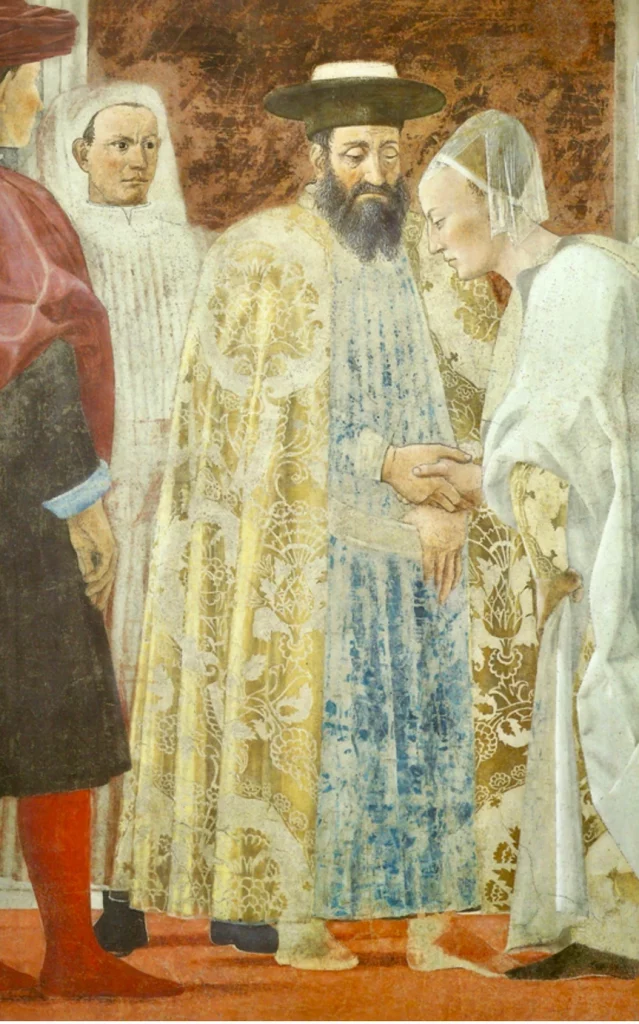
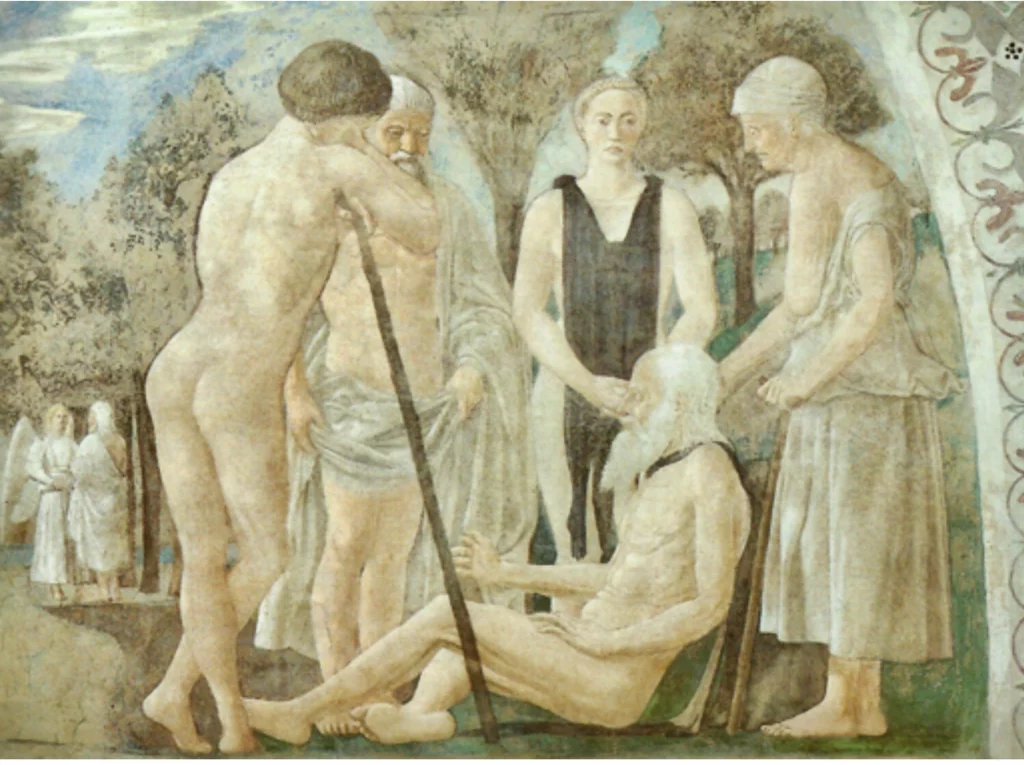
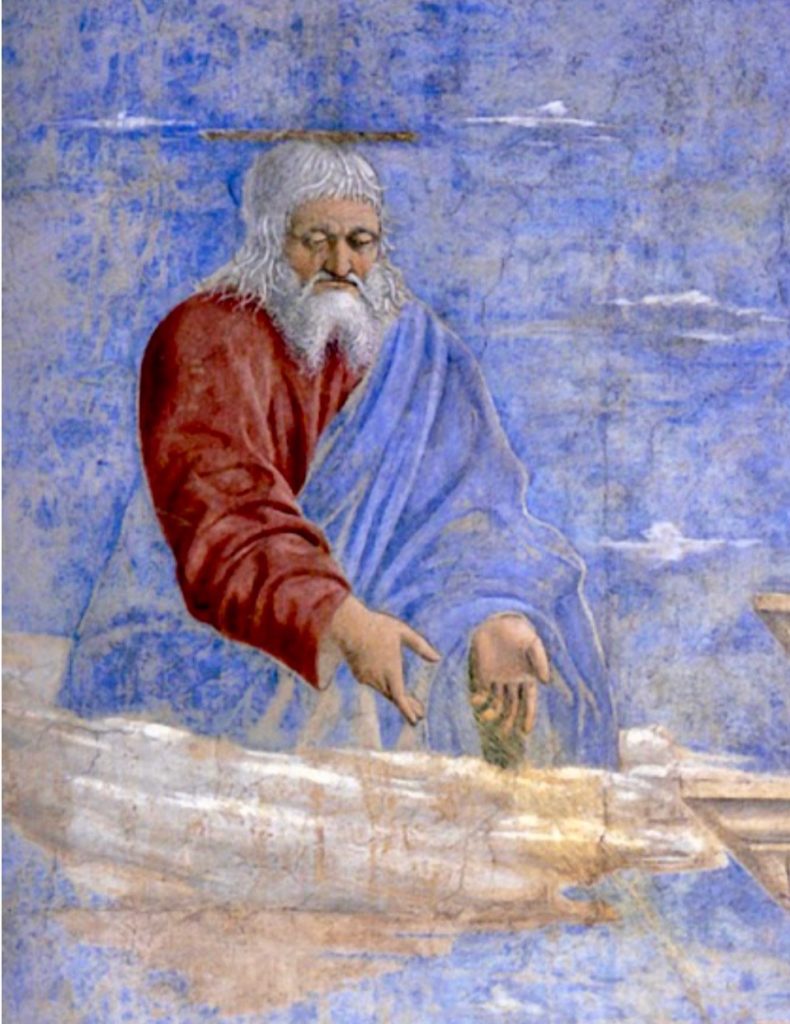
Piero painted the fresco cycle between 1452 and 1466. Filled with dramatic and inventive scenes, it’s a grail-like storybook romance of the True Cross.
Occupying the entire chapel, Piero’s cycle narrates a fanciful (sometimes confusing) medieval narrative about the true cross. It’s drawn from a l3th century legend recounted in the Golden Cross by Jacopo de Varagine, which is a collection of idealizing hagiographies.
Commissioned by the wealthy Bacci family, the fresco (and legend) trace the history of Christ’s cross. It follows a sprig from the Garden of Eden through many historic vicissitudes of the Old and New Testaments. Tree begets tree until we finally get to the wooden cross of the crucifixion. The overall theme is the triumph of the cross, which guides man to salvation.
Piero’s highly complex fresco cycle is quietly majestic, each scene rendered with solemnity. The fresco captures all the special traits of Piero’s art — spatial structure with prefect perspective, subtle and diffused light, and color contrast between warm and cold tones to create the illusion of space.
Piero’s images are so potent and pure that they ravish hearts. Giorgio Vasari claimed that the frescos were “so well-executed that but for the gift of speech they seemed alive.”
Close up, the figures assume personalties. They smile, observe, exalt, grieve, and die expressive deaths. As was the common practice at the time, Piero included discrete portraits of his patrons in the narrative.
Click here for my complete guide the Piero’s Legend of the True Cross, telling you about each of the 12 scenes.
- Address: Basilica of San Francesco, Piazza S. Francesco, 1 52100 Arezzo
- Hours: Monday to Friday 9:00 am to 1:00 pm & 2:00 pm to 6:00 pm. Sunday 9:00 am to 1:00 pm
- Ticket Price: 12 €. You must book in advance to visit. You can’t just walk in.
- Parking Lots: click here
2. Sansepolcro, Civic Museum
Your next stop on the Piero della Francesca Trial is Piero’s birthplace of Sansepolcro. It’s a small town in southern Tuscany, just 35 minutes from Arezzo.
The name Sansepolcro translates as “holy sepulcher.” The town allegedly owns parts of the sepulcher (tomb or monument), in which Christ was entombed.
After painting the frescos in Arezzo, Piero received a commission from a confraternity of mercy, better known as a Compagnia della Misericordia. Confraternities were groups performing charitable acts for the redemption of their souls. This confraternity commissioned a large altarpiece from Piero, which is Sansepolcro’s Civic Museum.
Piero’s piece is known as the Madonna della Misericordia. The painting is a polyptych, which is a painting done in many parts. It’s a rather old-fashioned technique pre-dating the Renaissance, reflecting the provincial taste of Piero’s patrons. Their coats of arms are in the bottom left and right of the painting.
The massive painting lost its frame. But the original panels have been reassembled in what art historians think is the correct order. The central image of the Virgin is about 6 feet tall.
The Virgin appears as a beautiful young woman. As is typical of Piero’s women, she is delicate, beautiful, and divine-looking. The Virgin stands majestically, spreading out her cape.
Gold leaf is in the background, a throwback to the Gothic style of painting. But you can still see the mathematical nature of Piero’s work. The kneeling figures are arranged in a circular format, protected by the madonna’s black cape.
On the left hand side, one figure wears a black hood. Back then, members of the confraternity wore hoods because charity was supposed to be a genuine act of goodness, not one which demanded recognition. Italy’s confraternities still exist. But they no longer wear hoods, because of the hood’s association with nefarious white supremacists in the United States.
Flanking the Virgin are four larger images of saints. Above her is an Annunciation scene. The critical piece is the Crucifixion, which resembles Masaccio’s crucifixion in the Holy Trinity fresco in the Church of Santa Maria Novella in Florence. At the bottom is a predella (base of altarpiece) with scenes from the life of Christ.
READ: 3 Day Itinerary For Florence
In the same building is another Piero fresco, his famous The Resurrection. The fresco is painted on the wall of what was once the communal palace, between corbels. It recently underwent a lengthy restoration in Florence.
What you see in Piero’s painting is a triumphant (and rather confrontational) image of an abdomen-flexing Christ rising from a Roman style marble sarcophagus.
A powerful and sculpted Christ puts all his weight on his right leg. His left leg rests on a cornice. He levels a hypnotically powerful gaze at the viewer.
Christ is perfectly static and naturalistic as he stares out at the viewer. He appears almost supernatural, as if he indeed just emerged from another world. Sleeping soldiers surround the base, “protecting” his tomb and creating mass in the painting.
One soldier (to the right) reclines in a truly awkward and unreal position. Art critics have given Piero some flack for his incorrect depiction of human anatomy. In the left center is what is assumed to be a self portrait of Piero.
Just 30 minutes from the museum is the house that Piero designed and lived in. The first floor, at least, is original and unaltered. You can visit the house for an extra euro with your civic museum ticket.
- Address: Via Niccolo’ Aggiunti 65, 52037, Sansepolcro Italy
- Hours & Tickets: click here
3. Monterchi, Madonna del Parto Civic Museum
Monterchi is a small relic of a village, perched on top of a hill near Arezzo in the upper Tiber Valley. You likely wouldn’t visit Monterchi except to see a revered Piero masterpiece in the town’s Civic Museum. The museum contains the world’s most famous portrait of an expectant Virgin, Piero’s Madonna del Parto, restored in 1993.
The Madonna del Parto is the sole display in a retrofitted school house. The exquisite painting is behind glass, flanked by three rooms of interpretive displays. The talismanic painting is a detached fresco once located in a church (that no longer exists), which is now a pilgrimage site for pregnant women.
According to legend, Piero painted the Madonna del Parto in 7 days. He allegedly used his mother as a model for the Virgin with the swollen belly.
Looking at the rare and imposing fresco is an intimate experience. You’re in a small town. You may be the only person in the room. It’s just you and a 9 x 7 feet naturalistic fresco of a pale and pregnant woman with a distended abdomen looking quite uncomfortable. It’s as if the Virgin has been summoned for a performance she’d rather skip.
The image is extraordinary. By Piero’s understated standards, the monumental Madonna del Parto is a theatrical image. A heavily pregnant Mary stands in a 3/4 pose in an ermine-lined pavilion.
Her hands are on the back and heaving belly of her burgeoning maternity gown. Mary is being unveiled by two carbon copy angels moving damask curtains decorated with pomegranates.
The fresco is a an all-too-human image, painted with sincerity. Mary is an actual person, not an unassailable matriarch. There’s an almost imperceptible melancholy, perhaps the standard fear that goes along with childbirth. Piero has produced an incredibly relatable and timeless image.
The angels in the fresco are reverse images of each other. Piero used the same cartoon (preliminary drawing) for both angels, just changing the color scheme.
If you get up close you can see little dots. They’re marks from Piero and his assistants transferring and pinning his cartoon to the west plaster.
- Address: Via della Reglia 1 52035 Monterchi (AR)
- Hours: click here
- Tickets: 6.50 €. Pregnant women get free admission. There’s also a short informational film on the painting with English subtitles.
4. Urbino, National Gallery of the Marches in the Ducal Palace
The Piero trail then moves to Urbino. Urbino is an elegant and well-preserved medieval town in the Le Marche region of Italy. Urbino is a designated UNESCO site and important town for Renaissance art.
Urbino was a court town ruled by Federico da Montefeltro, the Duke of Urbino. He was considered the most successful and feared of mercenary generals.
Montefeltro wanted to build a Renaissance court, much like Lorenzo the Magnificent had created in Florence at the magnificent Medici palaces. From 1468 onwards, he invested more money in art and architecture than any other Italian ruler. The beautiful Palazzo Ducale is his greatest legacy.
The palace houses the National Gallery of the Marches. The museum has two small, yet important works, by Piero: The Flagellation of Christ and Madonna and Child With Two Angels.
Flagellation
The Flagellation of Christ is one of Piero’s greatest and most controversial paintings, created sometime between 1455 to 1460. Art historian Kenneth Clark described it as “the greatest small painting in the world.”
Though exceeded in fame by The Legend of the True Cross, The Flagellation draws the most scholarly attention. Why? Because no one simply knows what the enigmatic painting is about. The iconography is ambiguous. It has a formal and conceptual complexity.
The Flagellation is a tiny painting, 23 tall by 32 inches wide, proof that good things can come in small packages. The painting reflects Piero’s preoccupation with the Classical world, as evidenced by the architecture and golden statue. There are two distinct scenes on the left and right.
Piero’s painting violates a cardinal principle of Christian narrative illustration. The gruesome biblical subject, Christ being flogged, is marginalized in the left background. There’s no apparent connection with the scene on the right with three figures. But because of the deliberate similarity of composition, there is some formal analogy between the two groups.
The left side is straightforward. It shows Christ being whipped before Pontius Pilate. But the three figures on the right side? Scholars have no idea who they are or what they represent.
There are various theories associated with the work, with no scholarly consensus. A tiny painting has stirred up a great controversy.
The traditional theory is that the young man in the center is Oddantanio da Montefeltro, ruler of Urbino, flanked on either side by his closest advisors. All three of these men were murdered in a conspiracy.
Frederico de Montefeltro could have commissioned Piero to commemorate his half brother Oddantanio’s death and compare his innocence to Christ. The only problem with this theory is that Montefeltro claimed that the assassination was water under the bridge. But perhaps he thought that such a small painting, purely for private viewing, wouldn’t attract public notice and thereby undermine his claim.
Another historian proposed that the two men in the painting are the blue-clad Ludovico Gonzaga and a colleague, an astrologer. The duo had contemporaneously lost their sons, which is signified by the young man in the center. In this interpretation, the art compares the pain that the two friends felt to that of Jesus during his passion.
Yet another interpretation suggests that the painting is a symbol or allegory for the grief over the fall of Constantinople to the Muslims. This theory is based on the figure with his back to the viewer, wearing a turban. The painting’s frame, long lost, may support this interpretation and hold another clue.
It originally had an inscription, which translates to “they came together as one.” In 1459, an ecumenical council took place in Mantua, with many great leaders convening to react to the fall of Constantinople. This inscription could represent the council “coming together.”
Under this interpretation, the two men in front of the flagellation scene are Murad II, the Islamic sultan, and Byzantine Emperor John VIII Palaiologos. The three figures on the right are Ludovico Gonzaga, a Byzantine leader (because he’s fork-bearded), and an angelic figure in the middle.
In the final analysis, no one knows what the Flagellation really represents. Many theories abound. Much ink has been spilled. But that’s part of the beauty of the painting. Typical of the Renaissance, it’s a mysterious work filled with metaphor and illusion.
Madonna and Child with Two Angels
The second Piero painting in the museum is Madonna and Child With Two Angels. Unmistakably Piero-esque characters, Mary holds an adult-looking baby Jesus. Against the cool gray wall, you can see Piero’s keenly observed treatment of light. There are reflections in the objects on the shelf and dust revealed by the sunlight streaming through the window.
In 1975, Piero’s Flagellation and Madonna were stolen, along with a painting attributed to Raphael. The sensational art heist was likely an inside job because renovation were being done on the building.
The story goes that the scaffolding was banging against the windows and setting off the museum alarm. So the caretaker deactivated the alarm. Someone who knew this fact then used the scaffolding to sneak into the museum and steal the paintings.
What the thieves discovered, however, is that it’s difficult to sell such well known paintings. So after weeks of searching for a buyer, they gave up. The thieves turned the painting in to the police via an anonymous tip.
- Address: Palazzo Ducale di Urbino, Piazza Rinascimento 13, 61029 Urbino PU
- Hours: Tuesday through Sunday from 8:30 am to 6:15 pm, closed Mondays
- Tickets: 8 €
5. Rimini, Church of San Francesco
Rimini is rather a tacky town on Italy’s Adriatic Coast. It’s best known for its sprawling grubby beaches and nightlife.
Rimini only has one sublime building, the Malatesta Temple aka the Church of San Francesco. Named after the Rimini overload Sigismondo Malatesta, the one nave church is a grandiose building, designed by famed Renaissance architect Leon Battista Alberti. It’s unfinished because Malatesta fell out of favor and was excommunicated by the pope.
But before, that, in 1451, Malatesta summoned Piero to Rimini to paint a picture of him. It’s likely that Piero met Alberti in Rimini.
This is significant because Alberti wrote a three volume treatise on art, called On Painting. In it, he discussed one point linear perspective and the concepts of composition and proportion. Alberti likely influenced a young Piero.
Anyway, Piero arrived and began work at the Malatesta Temple. He left a votive fresco, the monumental St. Sigismund and Sigismondo Pandolfo Malatesta.
The detached fresco is on display in a chapel in the right aisle. It was originally located above the entrance to the sacristy. The fresco shows his patron, Malatesta, in profile kneeling before his patron saint Saint Sigismund. Malatesta appears calm and dignified.
The fresco is a relatively early work by Piero. The simple composition, with its accurate perspective and the lack of movement, are still characteristic of his later style. The architecture, with the white pilasters in the background, are Alberti-influenced and a reference to the church itself.
Aside from Piero’s fresco, you can also admire a Giotto crucifix, canvases by Giorgio Vasari, and sculptures by Agostino di Duccio in the side chapels.
- Address: Via IV Novembre 35, 47900 Rimini
- Hours: Open daily from 8:30 am to 12:00 pm & 3:30 to 6:30 pm
- Tickets: free admission
6. Perugia, National Museum of Umbria
The official Piero della Francesca Trail in Tuscany and Umbria ends in Perugia. There, you’ll find a splendid Piero altarpiece in the National Museum of Umbria. Today, it’s considered a Renaissance blockbuster.
The Polyptych of Perugia is a multi-pictoral painting by Piero finished around 1470. Piero began it after his return from Rome.
The work was executed for the Franciscan convent of Sant’Antonio da Padova in Perugia. It depicts the Virgin enthroned with the child in the central part, beneath a marble niche with coffered dome.
The pair are flanked by several saints. At the top is the best part, an Annunciation scene. It’s beautiful, set in a bright cloister. The scene features a colonnade with an illusionist perspective, one of the greatest perspective renderings of Renaissance art. It’s reminiscent of the Borromini Perspective Gallery in the Palazzo Spada in Rome.
The central part of the polyptych is executed in an archaic style, with an old fashioned gold background. It’s wasn’t Piero’s choice. He was completed a work begun by a local painter.
- Address: Corso Pietro Vannucci, 19, 06121, Perugia
- Hours: Tuesday to Sunday from 8:30 am to 7:30 pm
- Tickets: 8 €
6. Milan, Pinacoteca di Brera
Now, we turn to three Piero works that are in accessible museums. First, the wonderful and underrated Pinacoteca di Brera in Milan owns a luminous Piero work, Virgin and Child With Saints and Angels. It was commissioned by Federico da Montefeltro, and may have been intended for the duke’s tomb.
This is an enormous altarpiece from 1472-74, originally in the church of San Bernardino in Urbino. The picture is a version of what art historians call “sacra conversazione.”
In a meticulously applied perspective, 13 figures fill the space in perfect harmony. Naturally, the Virgin is at the center, hands pressed to her chest sitting on a bench not a throne.
An ostrich egg looms above the Virgin. It’s unclear exactly what the egg symbolizes. Scholars suspect either the immaculate conception or the motif of birth itself.
Four angels flank the Virgin. Around her, arranged from the left, are: St. John the Baptist, St. Bernardine, St. Jerome beating his breast with a stone, St. Francis displaying the stigmata, St. Peter Martyr with the wound on his head, and St. John the Evangelist. Behind them, kneeling in front of the sacred group is Federico da Montefeltro in military dress.
Here’s my complete guide to the Brera Museum.:
- Address: Via Brera 28
- Opening Hours: Tuesday and Wednesday from 9:30 am to 1:30 pm & Thursday to Sunday, from 2:00 pm to 6:30 pm
- Entry fee: € 15
7. Venice, Galleria dell’Accademia
Piero also has a piece at Venice’s acclaimed Galleria dell’Academia, along Venice’s Grand Canal. The Accademia is the most important museum in Venice and one of the best in Europe. It’s housed in a former church, built, in part, by Italian Renaissance architect Andrea Palladio.
In 1451, Piero painted the small panel, St Jerome and a Donor. For the first time, Piero signed his work. His signature is on the tree trunk that forms the base of the Crucifix in the left hand corner. In the foreground, there’s an inscription indicating that the panel was commissioned by Gerolamo Amadi “veneziano,” who’s shown kneeling in prayer before the saint.
The donor and his protecting saint appear to converse as equals. Piero intended to exalt the human dignity of his patron. St. Jerome sites on a stone bench, wearing a tunic tied with a belt of thorny twigs.
There are bright hues in a clear sunlit atmosphere. In the background, Piero’s landscape features bare hills, only partially covered with vegetation burnt out by a Mediterranean sun (perhaps a reference to Sansepolcro). The city walls are made of white lime and the water of the river is transparent.
Here’s my complete guide to Venice’s Galleria Accademia. Click here to pre-book a ticket.
- Address: Campo della Carita Dorsoduro
- Hours: Monday from 8:15 am to 2:15 pm, Tues through Fri 8:15 am to 6:15 pm
- Tickets: € 12
8. Florence, Uffizi Gallery
Although the Legend of the True Cross in his defining masterpiece, Piero is better known for his painting of the Duke and Duchess of Urbino in Florence’s Uffizi Gallery.
The amazing Uffizi houses the world’s best and most abundant collection of Italian medieval and Renaissance art. The museum is a crowd pleaser, the third most visited site in Italy. It deserves its accolades and should be on your bucket list and itinerary for Florence.
Piero’s famous painting is a double portrait that used to be a diptych. It was hinged like a book, with landscape scenes painted on the back. Piero’s painting is one of the most celebrated portraits of the Renaissance.
It’s a strange juxtaposition and unflattering portrayal of the couple. The couple is together, but apart. Only a background landscape, rare for that time in painting, connects them.
The duchess’ pale wan skin contrasts sharply to the duke’s bronze tones. She has a very high forehead, which was the fashion then. Women even plucked their forehead back to achieve the desired effect. The duchess had just died and this was a commemorative portrait.
The portrait favors the duke’s good side. In a joust, Montefeltro lost his right eye and a chunk of his nose, which Piero portrays unflinchingly.
On the back panel is an elaborate scene. The duke and duchess each ride in an antique wagon. She is dressed in finery and he is dressed in gleaming armor. An inscription exalts the couple, stating the the duke “rides illustrious in glorious triumph.”
Here’s my complete cuide to the Uffizi Gallery. To visit, you’ll need to book a timed entry ticket online.
- Address: Piazzale degli Uffizi, adjacent to the Piazza della Signoria
- Hours: Open daily 8:15 am to 6:50 pm Tuesday-Sunday, closed Mondays.
- Entry fee: € 20
I hope you’ve enjoyed my guide to the Piero della Francesca Trail. You may enjoy these other travel guides and resources for Italian art:
- Best Museums in Rome
- Best Museums in Florence
- All of Leonardo da Vinci’s Paintings
- All The Last Supper Paintings From Renaissance Italy
- Guide To Visiting Leonardo’s Last Supper in Milan
- The Bernini Guide To Rome
- The Caravaggio Guide To Rome
- Guide To Rome’s Borghese Gallery
- Guide to Rome’s Palace Museums
- Masterpieces of the Vatican
If you’d like to follow the Piero della Francesca Trail in Italy, pin it for later.

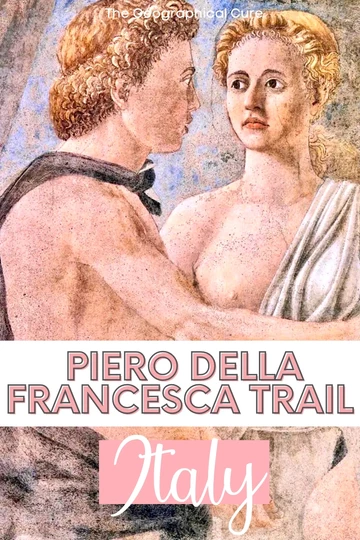
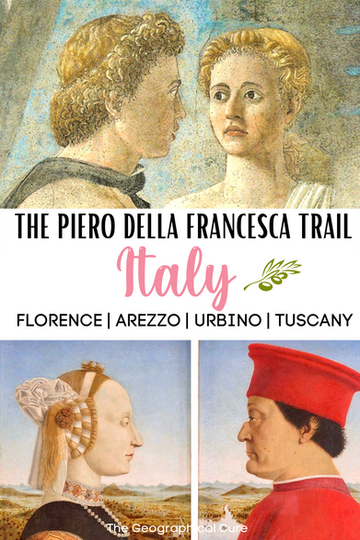
Brava on your research and article!
Thank you Marco!
yes well done, very interesting text and presentation.
sonia
thank you Sonia!